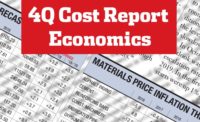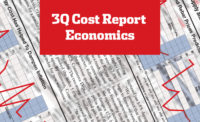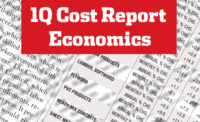There was a lot of action this year in the normally slow-moving lumber-cost arena, with price-hikes strongly impacted by forces of nature and international litigation. Prices skyrocketed 13% in 2017, according to data from analytics firm IHS Markit.
“Prices reached unprecedented levels,” says the analytics company’s senior economist, Deni Koenhemsi, who cites fires in Canada and the successive U.S. hurricanes in August and September as factors in the 2017 surge.
She also points to this year’s escalating trade war over Canadian softwood-lumber imports to the U.S.
The U.S. International Trade Commission on Dec. 7 unanimously decided that the Canadian shipments have hurt U.S. lumber companies, a decision that clears the way for the U.S. Commerce Dept. to impose tariffs on the imports that the agency set as high as 23.76%.
The decision comes two years after the expiration of the softwood-lumber agreement between the U.S. and Canada. Claiming the measures are punitive, Canadian officials are appealing to the World Trade Organization and under NAFTA.
The National Association of Home Builders estimates the tariffs will add $1,360 to the price of a single-family home built next year in the U.S.
While IHS Markit predicts a 1.8% drop next year, “the lack of an agreement between these two close trading partners and the ongoing cases … creates uncertainty in the market, which poses a high upside pricing risk and, at times, may result in erratic pricing behavior in 2018,” says Koenhemsi. “The unwinding in lumber prices will continue throughout 2018, but prices will remain above long-term averages and will not drop to the levels we have seen in 2016 or to their long-term averages in the near term.”
ENR’s 2018 cost forecast sees a modest escalation next year, following an 11.4% surge in 2017.
There will be some relief in early 2018 structural-steel prices, with IHS Markit predicting a 0.1% decline, says John Anton, IHS Markit’s director of steel who predicts a rebound in the latter half of the year. “Upside risk not only has strong odds, but the hikes are potentially quite large,” says Anton. “Prices are spiking in Europe, and the U.S. should follow.” ENR’s 2018 cost index forecast predicts structural steel to rise 4% by the end of next year.
Asphalt prices already are set to rise 1% in 2018, increasing for the first time since 2014, according to IHS Markit. The firm also expects prices for aggregates and cement to continue their climb—by 4% and 4.3%, respectively.
Gypsum-wallboard product prices will continue an upswing next year, rising 5.9% on top of a significant 7.5% hike in 2017, compared to the 1.6% increase the previous year. “Several large gypsum-wallboard producers have already issued low-double-digit price-increase announcements for the first quarter of 2018,” says Koenhemsi. “Similar to 2017, we believe there will be some pushback against these requested price increases.”
Overall, ENR’s Building Cost Index, based on a lower proportion of labor costs, is expected to rise 3%, following a 3.3% increase in 2017. ENR’s Construction Cost Index, which jumped 3.3% this year, is predicted to rise 3.1% in 2018. Union labor rates make up 81% of the CCI and 66% of the BCI.
The Construction Labor Research Council, which tracks union wage-fringe settlements, notes that, through September, data indicate a 2.7% average increase in wages in 2018, following a 2.6% hike this year.
Regionally for all crafts, the Southwest Pacific, which includes Arizona, California, Hawaii and Nevada, reported pacts that had the highest 2018 wage rates in the U.S., at 3.4%. The West North Central region, which includes Iowa, Kansas, Missouri and Nebraska, reports those with the lowest wage increase, set at 2.2%. Carpenters are expected to see the highest wage increase in 2018, at 3.3%.





Post a comment to this article
Report Abusive Comment